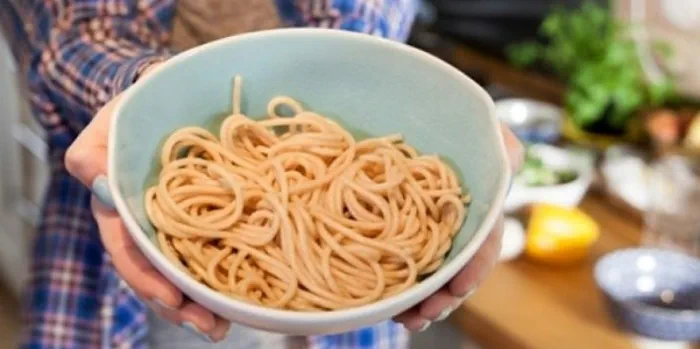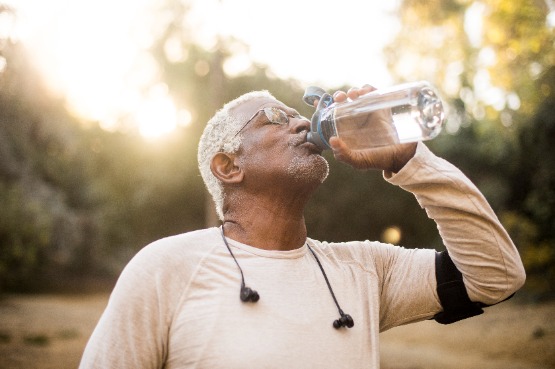Portion Size Guide
A healthy, balanced diet means having the right types of food and drink. Eating too much or too little of any of the major food groups can be bad for your health. So, you need to make sure you’re getting the right amounts.
Read on to find out more about the recommended portion sizes for the key food groups that will meet your nutritional and energy requirements.

Understanding food portion sizes
A portion is the amount of a particular food you eat at any one time. This may be the serving size of a food on your plate, or the amount of food in a packet. Being aware of different portion sizes in grams and other measurements can help you control how much food you’re eating. Lots of food labels show the nutrient content per serving or portion size.
As everyone is different, the recommended number of portion sizes for the key food groups will vary. You may need different portion sizes, depending on:
- how old you are
- your height and/or weight
- your sex
- your health
- how active you are
If you’re trying to lose weight, you’ll need to be particularly careful about portion control. You may need to eat smaller or fewer portions than what is suggested here. Ask your GP or a dietitian if you’re not sure how much you should be eating and drinking.
Recommended portion size for starchy foods
Starchy foods are your most important source of energy. It’s recommended that you include healthy, wholegrain starchy foods at every meal – these should make up just over a third of your diet.
Choose wholegrain, less-processed versions when you can, with less added fat, salt or sugar. This will help to make sure you get enough fibre, and feel fuller for longer.
The following are some suggested amounts that you might aim for at each meal. These are based on an average adult looking to stay the same weight.
Table: Recommended portion size for starchy foods
|
Food type |
Portion size |
How does this look? |
|---|---|---|
|
Puffed or flaked breakfast cereal |
30g (1oz) |
3 tablespoons |
|
Porridge oats or shredded cereal |
40g (1.4oz) |
3 tablespoons |
|
Muesli or granola |
45g (1.6oz) |
2 to 3 tablespoons |
|
Bread (or toast) |
34g to 36g (1.2 to 1.3 oz) |
1 medium slice |
|
Baked potato (with skin) |
180g (6.3 oz) |
1 medium-sized potato |
|
Potatoes (boiled with skin) |
175g (6.17 oz) |
5 to 6 (thumb-sized) new potatoes or 3 (egg-sized) potatoes |
|
Pasta (boiled) |
75g (2.6oz) uncooked or 150g (5.3oz) cooked |
2 to 3 tablespoons |
|
Rice (boiled) |
50g (1.8oz) uncooked or 150g (5.3oz) cooked |
2 to 3 tablespoons |
|
Food type |
Portion size |
How does this look? |
|---|---|---|
|
Puffed or flaked breakfast cereal |
30g (1oz) |
3 tablespoons |
|
Porridge oats or shredded cereal |
40g (1.4oz) |
3 tablespoons |
|
Muesli or granola |
45g (1.6oz) |
2 to 3 tablespoons |
|
Bread (or toast) |
34g to 36g (1.2 to 1.3 oz) |
1 medium slice |
|
Baked potato (with skin) |
180g (6.3 oz) |
1 medium-sized potato |
|
Potatoes (boiled with skin) |
175g (6.17 oz) |
5 to 6 (thumb-sized) new potatoes or 3 (egg-sized) potatoes |
|
Pasta (boiled) |
75g (2.6oz) uncooked or 150g (5.3oz) cooked |
2 to 3 tablespoons |
|
Rice (boiled) |
50g (1.8oz) uncooked or 150g (5.3oz) cooked |
2 to 3 tablespoons |
Recommended portion size for non-dairy proteins
Proteins are important for your body because they’re involved in growth and repair. Proteins come from meat and fish. They also come from vegan and vegetarian sources, such as beans and pulses. Include moderate amounts of protein in your diet – two or three portions throughout the day should be enough to give you what you need.
The following are some examples of what counts as a portion.
Table: Recommended portion size for non-dairy proteins
|
Food type |
Portion size |
How does this look? |
|---|---|---|
|
Cooked meat |
90g (3.2oz) |
A deck of cards |
|
Cooked fish |
140g (4.9oz) |
Palm of hand |
|
Eggs |
120g (4.23 oz) |
2 medium-sized eggs |
|
Baked beans |
150g (5.3oz) |
4 tablespoons |
|
Lentils or chickpeas |
150g (5.3oz) |
4 tablespoons |
|
Tofu, soya or other meat alternative |
100g (3.53 oz) |
4 tablespoons |
|
Unsalted nuts or nut butter |
30g (1 oz) |
1 tablespoon |
|
Food type |
Portion size |
How does this look? |
|---|---|---|
|
Cooked meat |
90g (3.2oz) |
A deck of cards |
|
Cooked fish |
140g (4.9oz) |
Palm of hand |
|
Eggs |
120g (4.23 oz) |
2 medium-sized eggs |
|
Baked beans |
150g (5.3oz) |
4 tablespoons |
|
Lentils or chickpeas |
150g (5.3oz) |
4 tablespoons |
|
Tofu, soya or other meat alternative |
100g (3.53 oz) |
4 tablespoons |
|
Unsalted nuts or nut butter |
30g (1 oz) |
1 tablespoon |
Recommended portion size for dairy and dairy-free alternatives
You also need to include some dairy foods in your diet. These foods are an excellent source of calcium, which you need for healthy bones and teeth. They’re also another good source of protein. If you don’t eat dairy foods, you should have some fortified non-dairy alternatives, such as soya drinks and yogurts, instead. Fortified foods have extra vitamins and minerals added to them.
The following are some examples of what a portion size should look like. You need to have moderate amounts of dairy foods. Two or three portions a day, based on the amounts below, should be enough.
Table: Recommended portion size for dairy and dairy-free alternatives
|
Food type |
Portion size |
How does this look? |
|---|---|---|
|
Milk |
200ml (7floz) |
1 glass |
|
Yoghurt or fortified soya yoghurt |
125ml (4.4floz) |
3 tablespoons |
|
Hard cheese |
30g (1.1oz) |
1 small matchbox |
|
Food type |
Portion size |
How does this look? |
|---|---|---|
|
Milk |
200ml (7floz) |
1 glass |
|
Yoghurt or fortified soya yoghurt |
125ml (4.4floz) |
3 tablespoons |
|
Hard cheese |
30g (1.1oz) |
1 small matchbox |
Recommended portion size for fruit and vegetables
It is recommended that we try to eat at least five portions of different fruit and vegetables every day. The amount of fruit and veg you eat should make up just over a third of your diet.
You don’t have to eat fresh fruit and vegetables only. Dried, frozen, tinned, and juiced fruit and vegetables count too.
The following are some examples of what a portion looks like.
Table: Recommended portion size for fruit and vegetables
|
Food type |
Portion size |
How does this look? |
|---|---|---|
|
Apple / orange / pear / banana |
80g (2.8oz) |
1 medium size apple |
|
Kiwis /apricots /satsumas /plums |
80g (2.8oz) |
2 fruits |
|
Dried fruit (such as raisins) |
30g (1.1oz) |
1 tablespoon |
|
Berries |
80g (2.8oz) |
15 to 20 berries |
|
Grapes |
80g (2.8oz) |
10 to 12 grapes |
|
Peas /sweetcorn /carrots |
80g (2.8oz) |
3 heaped tablespoons |
|
Salad |
80g (2.8oz) |
Cereal bowl |
|
Cherry tomatoes |
80g (2.8oz) |
7 cherry tomatoes |
|
Food type |
Portion size |
How does this look? |
|---|---|---|
|
Apple / orange / pear / banana |
80g (2.8oz) |
1 medium size apple |
|
Kiwis /apricots /satsumas /plums |
80g (2.8oz) |
2 fruits |
|
Dried fruit (such as raisins) |
30g (1.1oz) |
1 tablespoon |
|
Berries |
80g (2.8oz) |
15 to 20 berries |
|
Grapes |
80g (2.8oz) |
10 to 12 grapes |
|
Peas /sweetcorn /carrots |
80g (2.8oz) |
3 heaped tablespoons |
|
Salad |
80g (2.8oz) |
Cereal bowl |
|
Cherry tomatoes |
80g (2.8oz) |
7 cherry tomatoes |
Oils and spreads in your diet
We need some fat in our diets , but this should mainly come from unsaturated fats. These include sunflower, rapeseed and olive oils, and spreads made from these oils.
Aim to have oils or lower-fat spreads based on these oils instead of saturated fats when you can. You still only need limited amounts of these in your diet. Oils and spreads containing saturated fats include butter, ghee, suet and lard.
Do you know how healthy you truly are? Bupa health assessments give you a clear overview of your health and a view of any future health risks. You'll receive a personal lifestyle action plan with health goals to reach for a happier, healthier you.
-
Sources Sources
- Portion sizes. British Dietetic Association. www.bda.uk.com, published April 2021
- The Eatwell Guide. Public Health England. assets.publishing.service.gov.uk, published September 2018
- Get portion wise! British Nutrition Foundation. www.nutrition.org.uk, last reviewed November 2021
- Starchy foods. British Nutrition Foundation. www.nutrition.org.uk, accessed October 2022
- The energy density approach. British Nutrition Foundation. www.nutrition.org.uk, accessed October 2022
- Weight loss: food fact sheet. British Dietetic Association. www.bda.uk.com, published September 2021
- Protein. British Nutrition Foundation. www.nutrition.org.uk, accessed October 2022
- A healthy balanced diet. British Nutrition Foundation. www.nutrition.org.uk, accessed October 2022
- Fat. British Nutrition Foundation. www.nutrition.org.uk, accessed October 2022
- Personal communication. Miss Ruth Conroy. Registered Dietitian, November 2022
- Limit red and processed meat. World Cancer Research Fund. www.wcrf.org, accessed November 2022
- Fat. British Nutrition Foundation. www.nutrition.org.uk, last reviewed June 2021
About our health information
At Bupa we produce a wealth of free health information for you and your family. This is because we believe that trustworthy information is essential in helping you make better decisions about your health and wellbeing.
Our information has been awarded the PIF TICK for trustworthy health information. It also follows the principles of the The Information Standard.

More diet and nutrition articles
Did you find our advice helpful?
We’d love to hear what you think. Our short survey takes just a few minutes to complete and helps us to keep improving our healthy lifestyle articles.
Legal disclaimer
This information was published by Bupa's Health Content Team and is based on reputable sources of medical evidence. It has been reviewed by appropriate medical or clinical professionals and deemed accurate on the date of review. Photos are only for illustrative purposes and do not reflect every presentation of a condition.
Any information about a treatment or procedure is generic, and does not necessarily describe that treatment or procedure as delivered by Bupa or its associated providers.
The information contained on this page and in any third party websites referred to on this page is not intended nor implied to be a substitute for professional medical advice nor is it intended to be for medical diagnosis or treatment. Third party websites are not owned or controlled by Bupa and any individual may be able to access and post messages on them. Bupa is not responsible for the content or availability of these third party websites. We do not accept advertising on this page.







